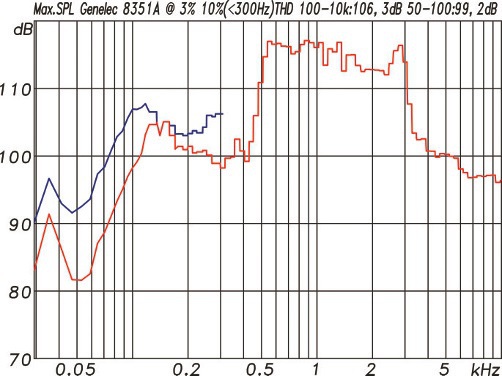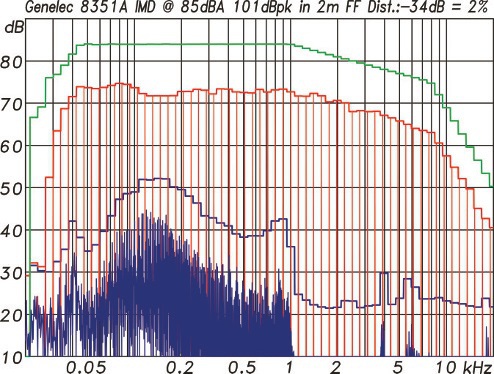SOME REFLECTIONS ON LOVE AND HATE IN AUDIO
(Warning! This text got a bit long, so not recommended for the twitter generation!)
I remember asking this question to a bunch of audiophiles:
"Let's say you had this audio system, NIRVANA101; it's invisible, takes no place, plays full range, no distortion at the very highest sound pressure levels. The price of the system is very low. Would you buy such a system?"
To my surprise, most if not all people didn't want this system. It would take the hobby out of audio, a couple of honest people said.
The NIRVANA101 system doesn't exist, of course. But let me rephrase:
"Let's say you had this producer of audio systems, active speakers and subwoofers with DSP. Ever since their start up 40 years ago, they have been following the narrow scientific path. Their first speaker was an active one. Today, they have a full product range intended for rooms from 55 m3 (cubic meters) to 400 m3 (i.e. 1950 ft3 to 14200 ft3). Their smallest speaker weighs 1.5 kg each, their biggest 193 kg (including external amplifier module) each. Needless to say, all speakers have adequate specifications for professional use. In the past 10-20 years, the company has developed and used sophisticated DSP to enhance the in-room qualities of otherwise ancehoically flat speakers of low distortion. The price of these audio systems is competitive. Would you buy such a system?"
Background: https://www.genelec.com/sites/default/files/media/Studio monitors/Catalogues/genelec_monitors_in-room_performance.pdf
To my surprise, these audio systems draws very little attention outside of the professional arena where time is money (you cannot have speakers that break down, or a speaker producer who cannot deliver replacement speakers that are 100 percent identical to the speakers they delivered many years ago, etc.). For example, these speakers are represented in two out of three OB vans (cars used in the field in broadcasting). The customer list is further populated by professionals like Grammy winners, an opera control room, universities etc.
If you follow a scientific route for 40 years, one would have thought that a company and its products would be regarded as the safe choice, totally uncontroversial, the leading star for others to follow. But that's not completely the case.
I think the company, Genelec, is the only speaker producer that has a thread on Gearslutz with "love hate" in the thread name. In 2015, a thread with the name "The love hate relationship with Genelec" was started. The opening poster writes:
"
When you read comments and reviews about most monitors in a certain price range, usually there is a certain amount of uniformity in the overall reaction... like with Focal, you read the forum and the general consensus is they are great monitors, some people don't like them as much or don't find then as flat as x, or as detailed as y, but you see very little of the word "hate" used with the brand. Same goes for many of the popular brands talked about on the forum... but man when you bring up Genelec, the field shifts to a gaping polarization. People either swear by them or can't stand them. There seems to be very little middle ground. Even pro reviews i've read (on the 8000 series) have very neutral conclusion. Like, " if you like the Genelec sound then you'll like these." So whats the deal? What is Genelec doing that folks either live by or can't stand?".
And the perceptions around the company - perceptions that are less related to reality than confusion - are alive on ASR as well. One user used the word "cult" to describe the company (
https://www.audiosciencereview.com/...nelec-on-audio-science.3110/page-3#post-79223), as if a cult company could get the major market share of, for example, the OB van market. Another ASR user wrote on Gearslutz that all the company's drivers are made in China, even if for example Genelec founder Ilpo Martikainen has stated in writing that some of their drivers are
made in-house in Finland and some are
made by Danish company Dynaudio. On the newest addition to the Genelec range of products, the company writes the following in a brochure: "All sub-systems of THE ONES including electronics, amplifier circuitry, drivers and system configuration are entirely designed, handmade and individually tested by craftsmen at our factory in Iisalmi, Finland".
According to listener preference research by Sean Olive, around 1/3 of the sound quality has to do with the bass handling of the audio system. In addition to the aforementioned speakers of every size, Genelec also produces a whole range of high-quality subwoofers; the smallest, 8 inches, weighs 19 kg and the biggest, 15 inches, weighs 69 kg. DSP enables the user to put together as many subs (maximum 30 speakers in one system) as he wants to create a system of subwoofers along the ideas of for example "Geddes-distributed-subs" etc.
In other words: The product range covers (almost) all needs.
I guess my fascination with and interest in Genelec has to do with my professional background outside of audio. In my profession, I have to deal with claims made by really (very!) smart people. Yet, high IQ and smartness could not over the decades stand in the way of the intelligent, science based alternative. So the intelligent, cheap alternative has taken huge market shares, while only the very best, "esoteric" solutions survive (well, some survive due to clever, subtle and complex marketing as well). To separate the robust, intelligent solutions from bullshit solutions makes you - I guess - a bit of a cynic over time.
As far as I can evaluate, Genelec represents a robust, intelligent, scientific choice. It's not - in any way - the final word in audio, but where are the alternatives that represent science, speakers that are extremely neutral, linear, reliable, serviceable, manufactured with very tight tolerances between units and batches over the years, and any speaker of same model may be paired with any other sample, even made years apart?
As a non-expert in audio (I have more professional competence in separating bullshit from the "signal", and from trying to understand why people repeatedly choose bullshit over a more nutritious diet), I think it's highly interesting to try and understand the design choices of such a company (as well as understanding how people react to such a company's offering in the market). My reasoning tells me that the beginner learns the fastest when he copies the behaviour of experts. And may we all have learned something recently? Because it seems like all or most forums member weren't aware of DSP based room compensation that uses Direct Sound information, as opposed to Steady-State information (with the implication that the DS curve should be flat, while an SS curve is tilted due to room influences). I find it interesting that Genelec's room compensation is DS based in order to improve in-room what many if not most people say cannot be improved, i.e. an anechoically flat speaker of low distortion.
To get back to the words in the title; love and hate. Why is it that a science based company leads to such emotions? Isn't science supposed to be emotion-free? Well, anyone who knows just a little about science sees that emotions are present in science as well. People are fighting for different paradigms, for positions and rank, and all the tricks in the book are used to make a fool out of a competing research program or a competing researcher.
Then comes the point that people like to make their own choices; overconfidence is a human, natural thing. Audiophiles like to tweak and tune. They listen to their systems instead of through their systems. And ASR is not so different, is it? We measure boxes that have an SNR of 130 and 140, but to what end? When does being fixated on specifications become counter-productive? Very few ASR members - if I am not mistaken - have opted for the active, fully integrated DSP based solution; instead, they follow a route that paradoxically resembles the old audiophile path with myriads of boxes, external DACs etc. The robust, intelligent and science-based alternative of a company with decades worth of science-based development of fully integrated products is - unexpectedly - of little interest to the crowd who like to be in the control of all the boxes in a complex audio system. Could the so-called
disposition effect explain it all, or is there something else as at play?
One thing I believe provokes some people about Genelec - including science interested people - is that they on the one hand like to read research articles on audio while on the other hand don't want to live by the rules of scientific insight. They don't want to marry, but keep all options open. Reading here and there about science gives you intellectual food for thought, i.e. the possibility to shop around for intellectual ideas, on a purely theoretical level. Intellectual gymnastics has its value, for sure. However, when a science-based company starts to make tangible products and integrated solutions, it cannot play on two horses at the same time; it needs to make priorities, choosing one solution over another. So if you want to keep all the options open, a fully integrated science-based solution is not for you; just in case a new, scientifically based idea is just around the corner. And in the background we have financial interests who give the impression that paradigms happen every two, three or five years. Myopia is certainly a common trait in audio as well.
Genelec is obviously not anything like NIRVANA101. Does Genelec give you the best sound in the universe? Probably not! It's just a readily available choice of the highest quality for people who want a science based audio solution for any need, from a company that over the years demonstrated competence, integrity, honesty and even benevolence; i.e. the ingredients normally mentioned by social scientists when they try and define trust (see opening post of mine for a perspective on these values). And it's a solution for people who want a trusted company to make all the relevant choices for them, from A to Z - as an integrated solution - on the playback side.
That certainly sets them apart in the world of audio. Loved by some. Hated by others.



